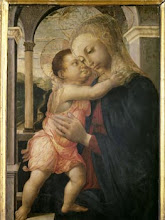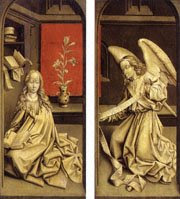
sabato
:: Andrea Del Castagno...


ANDREA DEL CASTAGNO
(b. 1423, Castagno, d. 1457, Firenze)
Biography
Andrea del Castagno (originally Andrea di Bartolodi Bargilla), one of the most influential 15th-century Italian Renaissance painters, best known for the emotional power and naturalistic treatment of figures in his work.
Little is known of Castagno's early life, and it is also difficult to ascertain the stages of his artistic development owing to the loss of many of his paintings. As a youth, he was precocious. He executed a mural of Cosimo de' Medici's adversaries (rebels hanging by their heels) at the Palazzo del Podestà in Florence, earning him the byname Andreino degli Impiccati ("Little Andrea of the Hanged Men"). It is known that he went to Venice in 1442, and frescoes in San Zaccaria are signed and dated by both him and Francesco da Faenza.
His first notable works were a Last Supper and three scenes from the Passion of Christ, all for the former Convent of Sant'Apollonia in Florence, now known as the Cenacolo di Sant'Apollonia and also as the Castagno Museum. These monumental frescoes, revealing the influence of Masaccio's pictorial illusionism and Castagno's own use of scientific perspective, received wide acclaim. In his altarpiece painting of the Assumption of the Virgin for San Miniato fra le Torri in Florence, Castagno's style more closely resembled International Gothic.
In 1451 Castagno continued the frescoes at San Egidio begun earlier by Domenico Veneziano. The light tones that Castagno adopted for his outstanding St Julian (1454-55) show Veneziano's influence.
In a work for a loggia of the Villa Carducci Pandalfini at Legnaia, Castagno broke with earlier styles and painted a larger-than-life-size series of Famous Men and Women, within a painted frame (now in the Castagno Museum, Florence). In this work, Castagno displayed more than mere craftsmanship; he portrayed movement of body and facial expression, creating dramatic tension. Castagno set the figures in painted architectural niches, thus giving the impression that they are actual sculptural forms. He achieved similar force in his Youthful David (National Gallery, Washington, D.C.), painted on a shield. His last dated work (Florence Cathedral) is an equestrian portrait of Niccolò da Tolentino.
Castagno's emotionally expressive realism was strongly influenced by Donatello, and Castagno's work in turn influenced succeeding generations of Florentine and Paduan painters.
:: Brocky, Karoly...







BROCKY, Károly
(b. 1807, Temesvár, d. 1855, London)
Biography
Hungarian painter, active in England. After his studies at the Art Academy in Vienna, he went to Italy in 1835, and to Paris in 1837, where he improved his art mostly by copying old pictures of the Louvre. He settled down in London in 1838, and he soon received orders from the Court. Besides portraits of Queen Victoria, Prince Albert, etc. he painted mythological pictures under the influence of Italian masters of the Renaissaince. His nudes and portraits of women full of life make his art attractive. The eclectic altarpiece, Christ and the Woman from Samaria, strongly reflecting the influence of Renaissance masters of Rome, was presented to the Lutheran church of Eperjes, but it burnt down in 1913. His works: Poverty, Woman in Yellow Clothes, Sleeping Bacchante, Woman in Black Clothes, Amor and Psyche, and Resting Psyche (Hungarian National Gallery)
martedì
:: Antonello da Messina...














ANTONELLO da Messina
(b. 1430, Messina, d. 1479, Messina)
Biography
Italian painter who probably introduced oil painting and Flemish pictorial techniques into mid-15th-century Venetian art. Vasari says that Antonello brought the 'secret' of oil painting to Venice. While this is probably untrue, his San Cassiano altarpiece was certainly influential, for several younger Venetian artists borrowed directly from it and Giovanni Bellini admired the modelling of its figures. His practice of building form with colour rather than line and shade greatly influenced the subsequent development of Venetian painting.
Little is known of Antonello's early life, but it is clear that he was trained in Naples, then a cosmopolitan art centre, where he studied the work of Provençal and Flemish artists, especially that of Jan van Eyck. His earliest known works, a Crucifixion (c. 1455; Museum of Art, Sibiu) and St Jerome in His Study (c. 1460; National Gallery, London), already show Antonello's characteristic combination of Flemish technique and realism with typically Italian modelling of forms and clarity of spatial arrangement.
In 1457 Antonello returned to Messina, where he worked until 1474. The chief works of this period, the polyptych of 1473 and the Annunciation of 1474 (both in the Museo Nazionale, Messina), are relatively conservative altarpieces commissioned by the church, but the Salvator Mundi (1465; National Gallery, London), intended for private devotions, is bold and simple, showing a thorough understanding of the human form and the depiction of personality. It was but a short step from the Salvator Mundi to such incisive characterizations of human psychology as seen in Portrait of a Man (c. 1475; National Gallery, London), a work that presaged the uncanny vitality and meticulous realism of such panels as Portrait of a Condottiere (1475; Louvre, Paris), which established his reputation in northern Italy.
From 1475 to 1476 Antonello was in Venice and possibly Milan. Within a short time of his arrival in Venice, his work attracted so much favourable attention that he was supported by the Venetian state, and local painters enthusiastically adopted his oil technique and compositional style. Among his known works from this period are a Crucifixion (1475, Koninklijk Museum voor Schone Kunsten, Antwerp) and the San Cassiano Altarpiece of which only two fragments remain (1475-1476, Kunsthistorisches Museum, Vienna). In St Sebastian (c. 1476; Gemäldegalerie, Dresden), his most mature work, Antonello achieved a synthesis of clearly defined space, monumental, sculpture-like form, and luminous colour, which was one of the most decisive influences on the evolution of Venetian painting down to Giorgione's day. In 1476 he was again in Messina, where he completed his final masterpiece, The Virgin Annunciated (c. 1476; Galleria Nazionale, Palermo).
lunedì
:: Boilly, Louis Léopold...










BOILLY, Louis Léopold
(b. 1761, La Bassé, d. 1845, Paris)
Biography
French painter and printmaker. The son of a wood-carver, Arnould Boilly (1764-79), he lived in Douai until 1778, when he went to Arras to receive instruction in trompe l’oeil painting from Dominique Doncre (1743-1820). He moved to Paris in 1785. Between 1789 and 1791 he executed eight small scenes on moralizing and amorous subjects for the Avignon collector Esprit-Claude-François Calvet (1728-1810), including The Visit (1789; Saint-Omer, Musée Hôtel Sandelin). He exhibited at the Salon between 1791 and 1824 and received a gold medal at the Salon of 1804. From the beginning his genre subjects were extremely popular with the public and collectors. In 1833, at a time when his popularity was declining, he was admitted to the Légion d’honneur and the Institut de France.
:: Amerling, Friedrich Von...




AMERLING, Friedrich von
(b. 1803, Wien, d. 1887, Wien)
Biography
Austrian painter. He came from a family of craftsmen and studied (1815-24) at the Akademie der bildenden Künste, Vienna, where one of his teachers was the conservative history painter Hubert Maurer (1738-1818). From 1824 to 1826 he attended the Academy in Prague, where he was taught by Josef Bergler. In 1827 and 1828 Amerling stayed in London, and he met the portrait painter Sir Thomas Lawrence, whose work was to be a strong influence on Amerling’s painting during the next two decades. Amerling also travelled to Paris and Rome but was recalled to Vienna on an official commission to paint a life-size portrait of the emperor Francis I of Austria (Vienna, Kunsthistorisches Museum). With this work, Amerling became the most sought-after portrait painter in Vienna, a position he was to retain for about 15 years. In addition, he was also a major painter of historic and genre pictures, and landscapes. He worked mostly for the arictocracy. He was the master of the Hungarian painter József Borsos.
Iscriviti a:
Commenti (Atom)
































.jpg)


.jpg)











